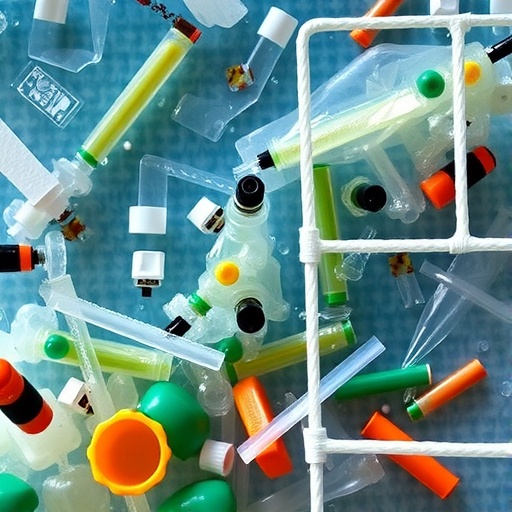The escalating issue of microplastic pollution in the world’s oceans is becoming one of the most critical environmental challenges of our time. Recent research has unveiled shocking data indicating that microplastic levels are now harmful to marine life, posing a significant threat to biodiversity and oceanic health. This new study, conducted by a team of scientists including Walton, Wedinger, and Mason, reveals the alarming extent to which microplastics have infiltrated marine ecosystems, raising urgent questions about the sustainability of marine species and, consequently, human well-being.
Microplastics, defined as plastic particles less than five millimeters in diameter, are prevalent across various marine environments, including open oceans, coastal regions, and even the deep-sea trenches. They originate from a variety of sources, such as the breakdown of larger plastic debris, synthetic clothing fibers, and microbeads from personal care products. Once these particles enter marine ecosystems, they can persist for decades, gradually accumulating in the environment and posing serious risks to marine organisms.
In marine habitats, microplastics can be ingested by a wide range of organisms, from plankton to larger fish and marine mammals. This bioaccumulation poses profound implications for the food chain, as toxic substances associated with microplastics—such as heavy metals and persistent organic pollutants—can transfer through successive trophic levels. As a result, microplastics not only affect the individual organisms that ingest them but also disrupt entire ecosystems and the services they provide.
The research highlights that marine organisms are facing unprecedented levels of microplastic exposure, leading to progressively harmful outcomes. The study has shown that both physiological and behavioral changes are being observed in marine wildlife due to microplastic ingestion. For instance, fish exhibit altered feeding behaviors, reduced reproductive success, and increased mortality rates, all of which hint at an ecological imbalance if the trend is left unchecked.
Furthermore, the implications extend to human health, as seafood is a prominent part of many diets globally. The consumption of microplastics can potentially compromise food safety, posing risks to human health. The idea that microplastics could find their way into the human body through marine food sources raises significant public health concerns, demanding immediate regulatory frameworks and consumer awareness.
Despite the growing body of evidence demonstrating the effects of microplastic pollution, global efforts to combat this issue remain insufficient. A lack of stringent regulations governing plastic production and disposal continues to exacerbate the problem. Additionally, public awareness about the presence and consequences of microplastics in the oceans is alarmingly low. Advocacy for change at both community and governmental levels is essential to mitigate this pervasive issue.
Another aspect of this research is the analysis of microplastic distribution in different marine environments. Some regions, particularly in proximity to urban centers and river estuaries, show higher concentrations. These hotspots are not mere coincidences; they are a direct result of human activities such as improper waste management, industrial runoff, and urbanization. Understanding these distribution patterns can inform targeted actions for reducing microplastics in the marine environment.
The findings of this research serve as a clarion call for conservationists, policymakers, and society at large to take decisive action. There is an urgent need for comprehensive policies that limit plastic production, encourage sustainable alternatives, and promote recycling initiatives. Beyond policy measures, education and engagement of the public are crucial elements in fostering a culture of environmental stewardship and responsibility.
International collaborations can also play a pivotal role in addressing the microplastic crisis. The ocean does not abide by national borders; thus, a coordinated global response is necessary. Cooperation among nations can facilitate sharing best practices, technological advancements, and research findings to combat microplastic pollution more effectively.
Innovative solutions are emerging as part of the response to this environmental challenge. Researchers are exploring biodegradable alternatives to conventional plastics, as well as enhanced waste management systems to prevent lanching of plastics into marine habitats. Such innovations could potentially reshape the materials economy and help to stem the tide of microplastic entry into the oceans.
As this research unfolds, it remains crucial to maintain momentum in spreading awareness about microplastics and their impacts. Public campaigns highlighting the importance of reducing plastic usage, advocating for sustainable practices, and supporting conservation efforts can amplify the message. Community-level actions like beach clean-ups and local conservation initiatives can also engage citizens in direct action against pollution.
In conclusion, the research spearheaded by Walton and colleagues underscores a vital narrative about the future of our oceans and the threats posed by microplastic pollution. As scientists continue to unravel the complexities of microplastics and their effects on marine life, it is imperative that individuals, communities, and governments unite in a concerted effort to address this pressing environmental crisis. Ensuring the health of our oceans is not just an ecological imperative but a moral obligation to future generations who will inherit the planet we leave behind.
In light of these insights, the responsibility to enact change falls on all of us. Whether through choosing sustainable products, supporting legislation that reduces plastic production, or participating in local clean-up efforts, each action contributes to the broader fight against microplastic pollution. The time to act is now, and by uniting our efforts, we can protect the precious marine ecosystems that support not only the richness of wildlife but also human life itself.
Subject of Research: Microplastic pollution in marine life.
Article Title: Global microplastic pollution at levels harmful to marine life.
Article References:
Walton, M.E.M., Wedinger, M., Mason, V. et al. Global microplastic pollution at levels harmful to marine life.
Environ Sci Pollut Res (2025). https://doi.org/10.1007/s11356-025-37149-x
Image Credits: AI Generated
DOI: https://doi.org/10.1007/s11356-025-37149-x
Keywords: Microplastics, marine life, pollution, ecosystems, biodiversity, human health, conservation, sustainable practices.




